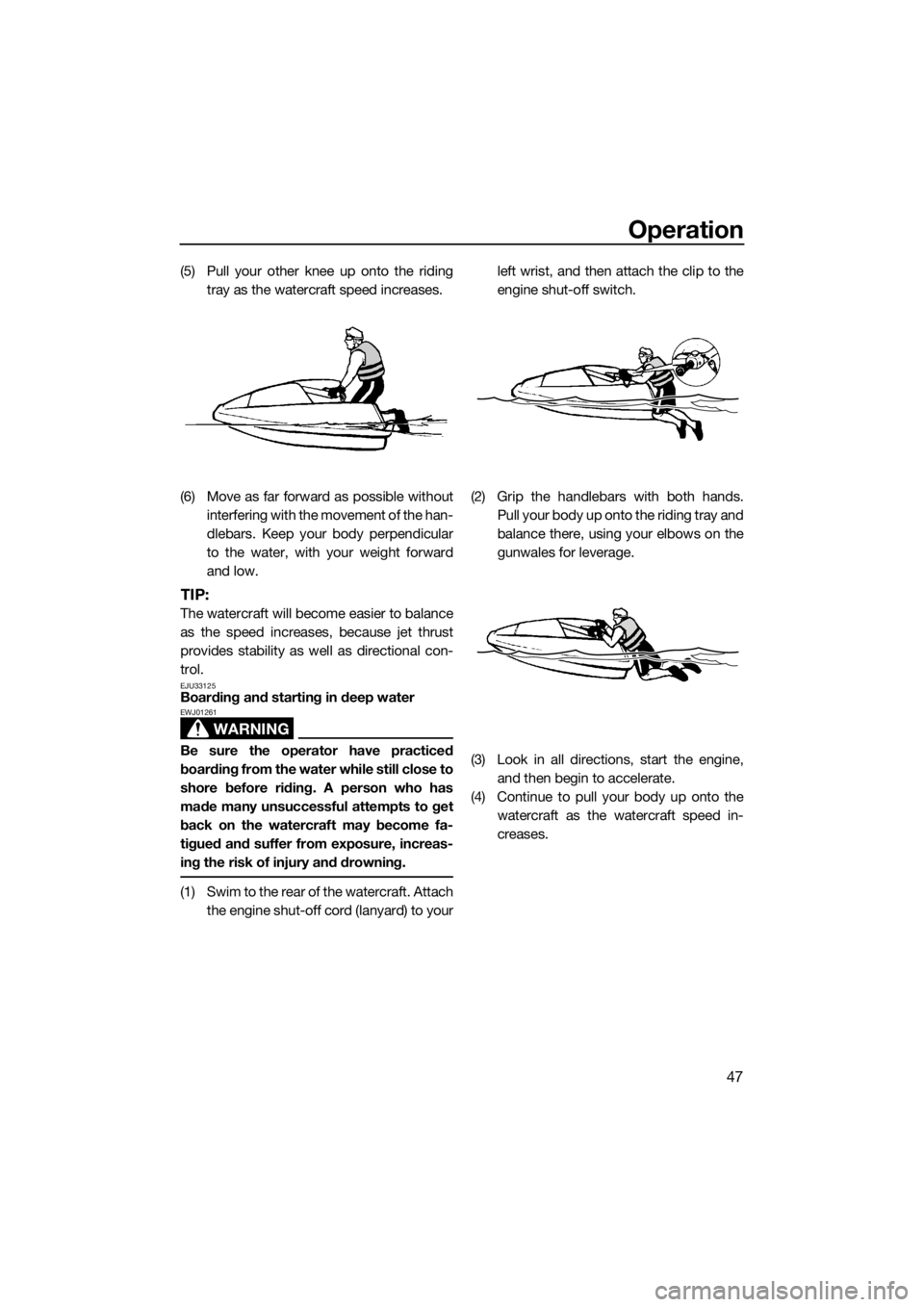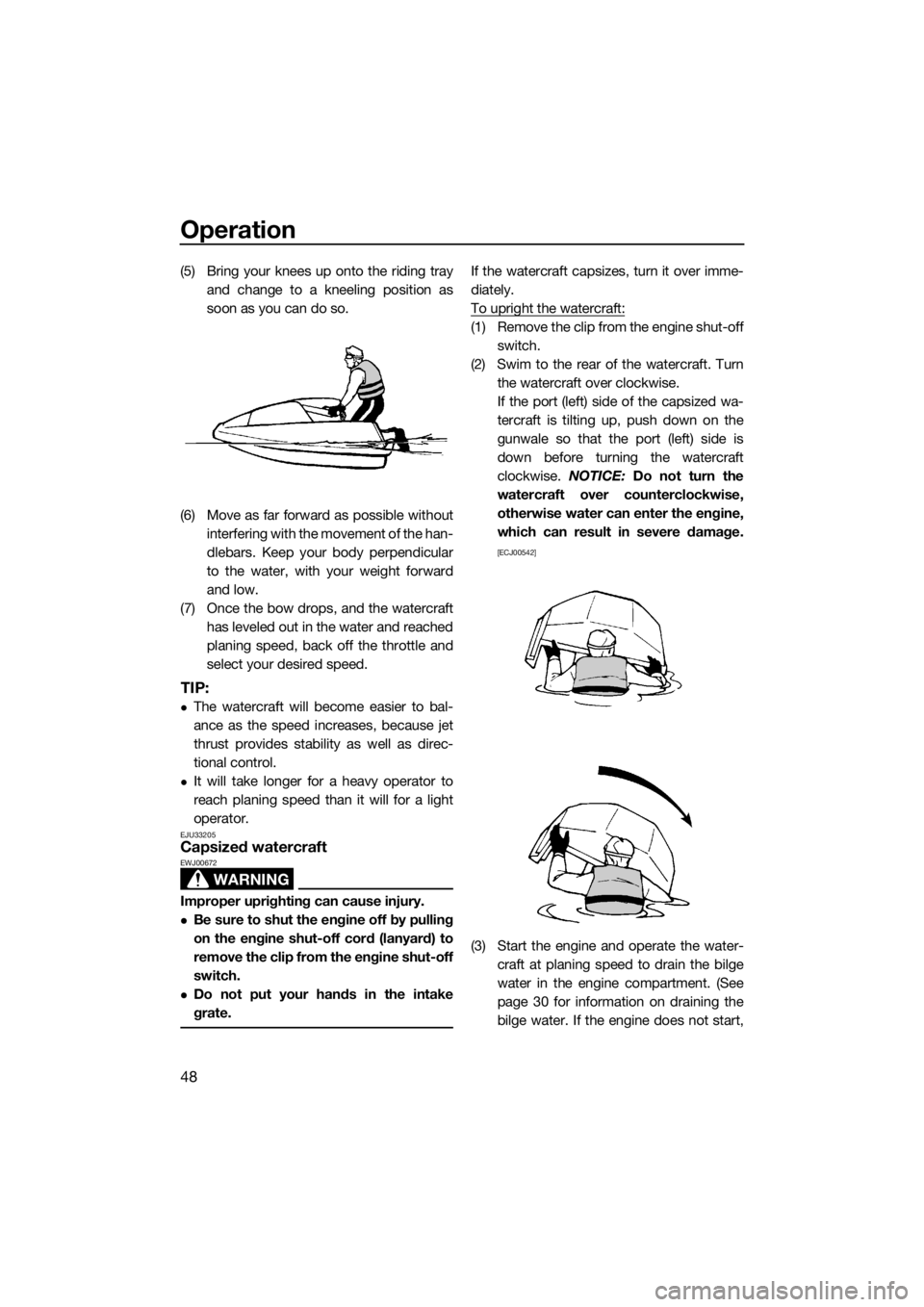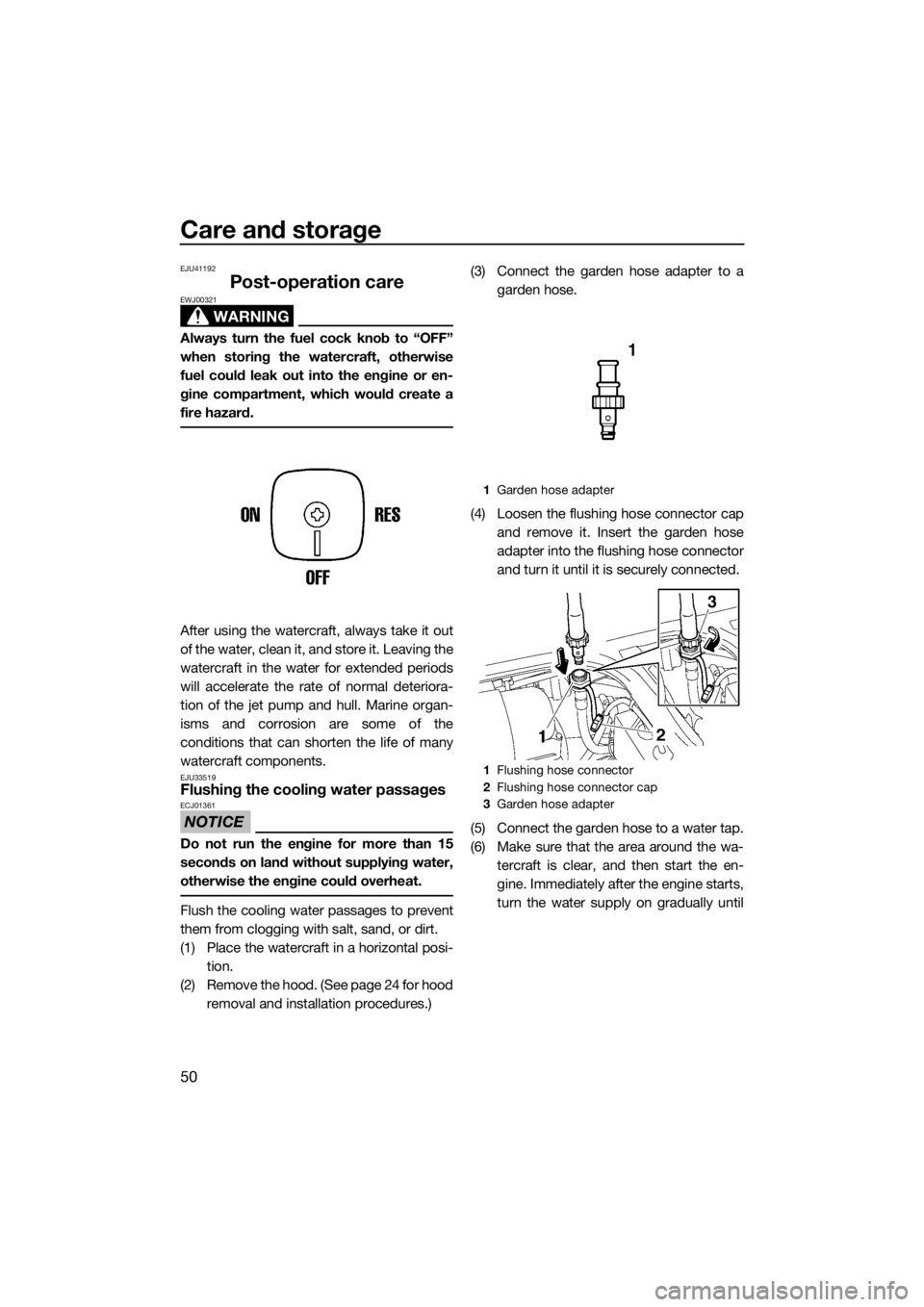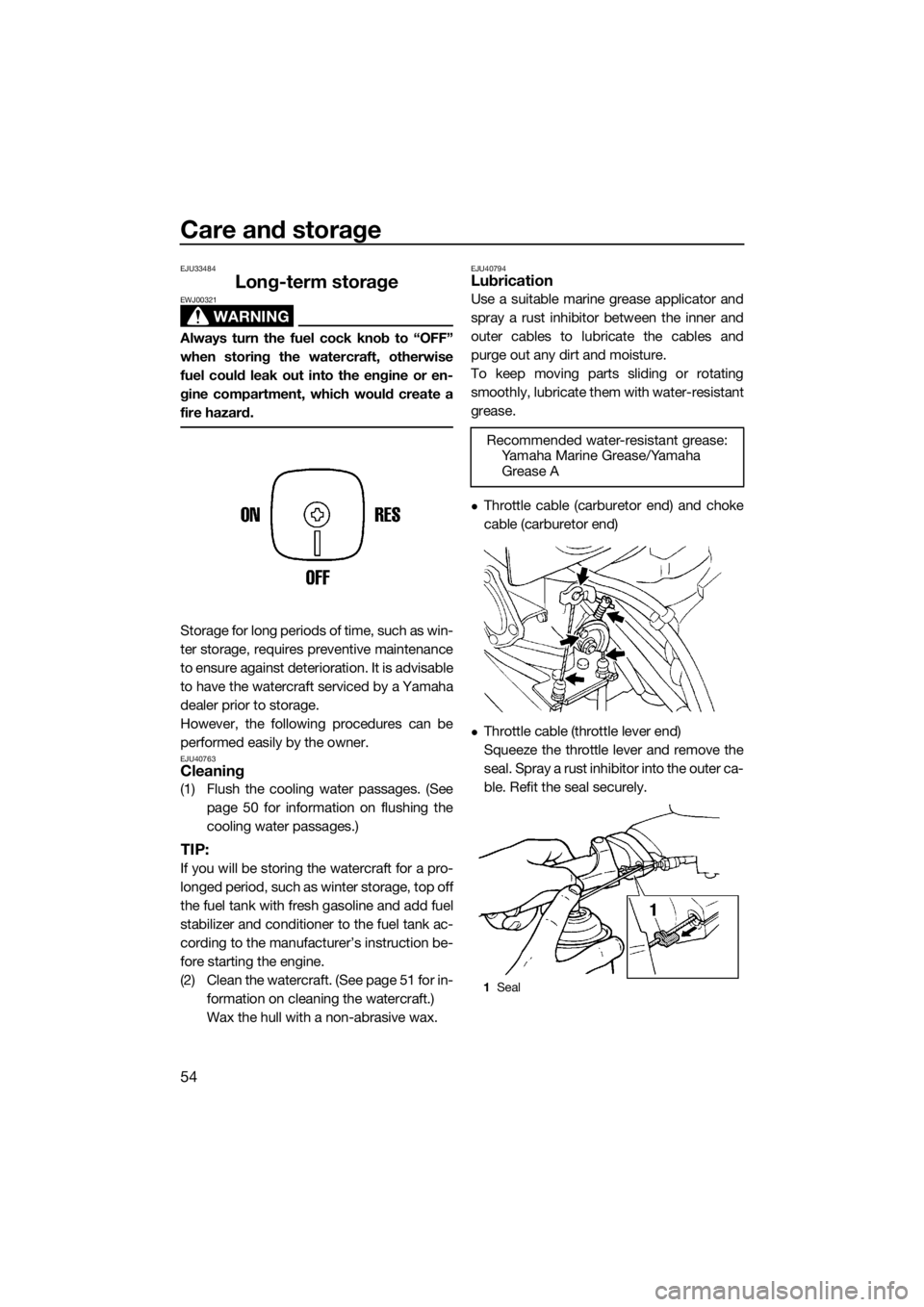2016 YAMAHA SUPERJET engine
[x] Cancel search: enginePage 53 of 78

Operation
47
(5) Pull your other knee up onto the riding
tray as the watercraft speed increases.
(6) Move as far forward as possible without
interfering with the movement of the han-
dlebars. Keep your body perpendicular
to the water, with your weight forward
and low.
TIP:
The watercraft will become easier to balance
as the speed increases, because jet thrust
provides stability as well as directional con-
trol.
EJU33125Boarding and starting in deep water
WARNING
EWJ01261
Be sure the operator have practiced
boarding from the water while still close to
shore before riding. A person who has
made many unsuccessful attempts to get
back on the watercraft may become fa-
tigued and suffer from exposure, increas-
ing the risk of injury and drowning.
(1) Swim to the rear of the watercraft. Attach
the engine shut-off cord (lanyard) to yourleft wrist, and then attach the clip to the
engine shut-off switch.
(2) Grip the handlebars with both hands.
P u ll y o u r b o dy u p o n t o t h e r i d i n g t r ay an d
balance there, using your elbows on the
gunwales for leverage.
(3) Look in all directions, start the engine,
and then begin to accelerate.
(4) Continue to pull your body up onto the
watercraft as the watercraft speed in-
creases.
UF4D71E0.book Page 47 Thursday, April 23, 2015 1:48 PM
Page 54 of 78

Operation
48
(5) Bring your knees up onto the riding tray
and change to a kneeling position as
soon as you can do so.
(6) Move as far forward as possible without
interfering with the movement of the han-
dlebars. Keep your body perpendicular
to the water, with your weight forward
and low.
(7) Once the bow drops, and the watercraft
has leveled out in the water and reached
planing speed, back off the throttle and
select your desired speed.
TIP:
The watercraft will become easier to bal-
ance as the speed increases, because jet
thrust provides stability as well as direc-
tional control.
It will take longer for a heavy operator to
reach planing speed than it will for a light
operator.
EJU33205Capsized watercraft
WARNING
EWJ00672
Improper uprighting can cause injury.
Be sure to shut the engine off by pulling
on the engine shut-off cord (lanyard) to
remove the clip from the engine shut-off
switch.
Do not put your hands in the intake
grate.
If the watercraft capsizes, turn it over imme-
diately.
To upright the watercraft:
(1) Remove the clip from the engine shut-off
switch.
(2) Swim to the rear of the watercraft. Turn
the watercraft over clockwise.
If the port (left) side of the capsized wa-
tercraft is tilting up, push down on the
gunwale so that the port (left) side is
down before turning the watercraft
clockwise. NOTICE: Do not turn the
watercraft over counterclockwise,
otherwise water can enter the engine,
which can result in severe damage.
[ECJ00542]
(3) Start the engine and operate the water-
craft at planing speed to drain the bilge
water in the engine compartment. (See
page 30 for information on draining the
bilge water. If the engine does not start,
UF4D71E0.book Page 48 Thursday, April 23, 2015 1:48 PM
Page 55 of 78

Operation
49
see “Towing the watercraft” on page 68
or “Submerged watercraft” on page 69.)
NOTICE: Do not run the engine at full
throttle for at least 1 minute after the
engine has been restarted. Bilge wa-
ter in the engine compartment can
splash into the engine, which can re-
sult in severe damage.
[ECJ00554]
EJU33303
Beaching the watercraft
To beach the watercraft:
(1) Make sure that there are no boats, swim-
mers, or obstacles near the beach.
(2) Release the throttle lever to reduce
speed about 90 m (300 ft) before you
reach the intended beaching area.
(3) Slowly approach the beach and stop the
engine just before reaching land.
WARNING! You need throttle to steer.
Shutting the engine off can cause you
to hit an obstacle you are attempting
to avoid. A collision could result in se-
vere injury or death.
[EWJ00602] NOTICE:
Never run the engine in water that is
less than 60 cm (2 ft) deep from the
bottom of the watercraft, otherwise
pebbles or sand could be sucked into
the jet intake, causing impeller dam-
age and engine overheating.
[ECJ00473]
(4) Get off the watercraft and pull it up on the
beach.
EJU37194Operating in weeded areas
Always avoid using your watercraft in areas
where weed growth is thick. If operating in
weeded areas is unavoidable, alternately
squeeze the throttle lever and relax your grip
on the throttle lever to vary the engine speed.
Weeds tend to become clogged more when
operating at a steady speed and at trolling
speed. If weeds may have clogged the intakearea, clean the jet intake. (See page 66 for in-
formation on the jet intake.)
EJU41061After removing the watercraft from
the water
NOTICE
ECJ01361
Do not run the engine for more than 15
seconds on land without supplying water,
otherwise the engine could overheat.
After operating and removing the watercraft
from the water, promptly discharge the re-
maining water from the cooling water pas-
sages.
To discharge water from the cooling water
passages:
(1) Make sure that the area around the wa-
tercraft is clear, and then start the en-
gine.
(2) Discharge the remaining water out of the
cooling water passages by alternately
squeezing and releasing the throttle lever
quickly for 10 to 15 seconds.
(3) Stop the engine.
UF4D71E0.book Page 49 Thursday, April 23, 2015 1:48 PM
Page 56 of 78

Care and storage
50
EJU41192
Post-operation care
WARNING
EWJ00321
Always turn the fuel cock knob to “OFF”
when storing the watercraft, otherwise
fuel could leak out into the engine or en-
gine compartment, which would create a
fire hazard.
After using the watercraft, always take it out
of the water, clean it, and store it. Leaving the
watercraft in the water for extended periods
will accelerate the rate of normal deteriora-
tion of the jet pump and hull. Marine organ-
isms and corrosion are some of the
conditions that can shorten the life of many
watercraft components.
EJU33519Flushing the cooling water passages
NOTICE
ECJ01361
Do not run the engine for more than 15
seconds on land without supplying water,
otherwise the engine could overheat.
Flush the cooling water passages to prevent
them from clogging with salt, sand, or dirt.
(1) Place the watercraft in a horizontal posi-
tion.
(2) Remove the hood. (See page 24 for hood
removal and installation procedures.)(3) Connect the garden hose adapter to a
garden hose.
(4) Loosen the flushing hose connector cap
and remove it. Insert the garden hose
adapter into the flushing hose connector
and turn it until it is securely connected.
(5) Connect the garden hose to a water tap.
(6) Make sure that the area around the wa-
tercraft is clear, and then start the en-
gine. Immediately after the engine starts,
turn the water supply on gradually until
1Garden hose adapter
1Flushing hose connector
2Flushing hose connector cap
3Garden hose adapter
UF4D71E0.book Page 50 Thursday, April 23, 2015 1:48 PM
Page 57 of 78

Care and storage
51
water flows out continually from the
cooling water pilot outlet.
(7) Run the engine at idling speed for about
3 minutes watching the engine condition.
If the engine stops while flushing, turn
the water supply off immediately and
perform the procedure again from step 6.
NOTICE: Do not supply water to the
cooling water passages when the en-
gine is not running. The water could
flow back through the muffler into the
engine, causing severe engine dam-
age.
[ECJ00123]
(8) Turn the water supply off.
(9) Discharge the remaining water out of the
cooling water passages by alternately
squeezing and releasing the throttle lever
quickly for 10 to 15 seconds.
(10) Stop the engine.
(11) Remove the garden hose adapter, and
then securely install the flushing hose
connector cap by tightening it until it
stops.
(12) Securely install the hood in its original
position.
EJU40743Cleaning the watercraft
(1) Remove the hood. (See page 24 for hood
removal and installation procedures.)
(2) Rinse the engine and engine compart-
ment with a small amount of water.
NOTICE: Do not use high-pressurewater when rinsing the engine or en-
gine compartment as severe engine
damage could result.
[ECJ00572]
(3) Wipe the engine and engine compart-
ment with a dry cloth.
(4) Wash down the hull, deck, and jet pump
with fresh water.
(5) Wipe the hull, deck, and jet pump with a
dry cloth.
(6) Wipe all vinyl and rubber components,
such as the engine compartment seals,
with a vinyl protectant.
(7) To minimize corrosion, spray metallic
parts of the hull, deck, and engine with a
rust inhibitor.
(8) Allow the engine compartment to air dry
completely before installing the hood.
(9) Securely install the hood in its original
position.
EJU33687Battery care
If the watercraft will not be used for more than
a month, remove the battery from the water-
craft, check it, and then store it in a cool, dry
place.
WARNING
EWJ00792
Battery electrolyte is poisonous and dan-
gerous, causing severe burns, etc. Elec-
trolyte contains sulfuric acid. Avoid
contact with skin, eyes, or clothing.
Antidotes
External: Flush with water.
Internal: Drink large quantities of water or
milk. Follow with milk of magnesia, beaten
egg, or vegetable oil. Call a physician im-
mediately.
Eyes: Flush with water for 15 minutes and
get prompt medical attention.
Batteries produce explosive gases. Keep
sparks, flames, cigarettes, etc., well away.
If using or charging the battery in an en-
UF4D71E0.book Page 51 Thursday, April 23, 2015 1:48 PM
Page 60 of 78

Care and storage
54
EJU33484
Long-term storage
WARNING
EWJ00321
Always turn the fuel cock knob to “OFF”
when storing the watercraft, otherwise
fuel could leak out into the engine or en-
gine compartment, which would create a
fire hazard.
Storage for long periods of time, such as win-
ter storage, requires preventive maintenance
to ensure against deterioration. It is advisable
to have the watercraft serviced by a Yamaha
dealer prior to storage.
However, the following procedures can be
performed easily by the owner.
EJU40763Cleaning
(1) Flush the cooling water passages. (See
page 50 for information on flushing the
cooling water passages.)
TIP:
If you will be storing the watercraft for a pro-
longed period, such as winter storage, top off
the fuel tank with fresh gasoline and add fuel
stabilizer and conditioner to the fuel tank ac-
cording to the manufacturer’s instruction be-
fore starting the engine.
(2) Clean the watercraft. (See page 51 for in-
formation on cleaning the watercraft.)
Wax the hull with a non-abrasive wax.
EJU40794Lubrication
Use a suitable marine grease applicator and
spray a rust inhibitor between the inner and
outer cables to lubricate the cables and
purge out any dirt and moisture.
To keep moving parts sliding or rotating
smoothly, lubricate them with water-resistant
grease.
Throttle cable (carburetor end) and choke
cable (carburetor end)
Throttle cable (throttle lever end)
Squeeze the throttle lever and remove the
seal. Spray a rust inhibitor into the outer ca-
ble. Refit the seal securely.
Recommended water-resistant grease:
Yamaha Marine Grease/Yamaha
Grease A
1Seal
UF4D71E0.book Page 54 Thursday, April 23, 2015 1:48 PM
Page 61 of 78

Care and storage
55
Steering cable ball joint (handlebar end)
and steering cable inner wire (handlebar
end)
To access the steering cable ball joint (han-
dlebar end) and steering cable inner wire
(handlebar end), remove the steering pole
cover. (See step 1 in “Adjusting the jet
thrust nozzle angle” on page 57 for infor-
mation on removing the steering pole cov-
er.)
Steering cable ball joint (jet thrust nozzle
end) and steering cable inner wire (jet
thrust nozzle end)
EJU40944Rustproofing
NOTICE
ECJ01361
Do not run the engine for more than 15
seconds on land without supplying water,
otherwise the engine could overheat.
Spray metallic parts of the hull and engine
with a rust inhibitor.
To rustproof the internal engine components:
(1) Remove the hood. (See page 24 for hood
removal and installation procedures.)
(2) Loosen the silencer cap and remove it.
(3) Make sure that the area around the wa-
tercraft is clear, and then start the engine
in a well-ventilated area.
(4) Run the engine at a fast idle.
(5) Quickly spray as much rust inhibitor as
possible through the hole in the silencer
cover. Keep spraying until the engine
stalls (or a maximum of 15 seconds).
WARNING! Do not pour or spray gaso-
line, or any substance other than a
rust inhibitor through the hole in the
silencer cover. Do not spray flamma-
ble rust inhibitor products on engine
surfaces while the engine is hot. Oth-
erwise, a fire or explosion could oc-
cur.
[EWJ00302]
(6) Securely install the silencer cap by tight-
ening it until it stops. NOTICE: Be sure
to install the silencer cap securely af-
ter fogging the engine, otherwise wa-
ter could enter the engine and cause
damage.
[ECJ00153]
(7) Securely install the hood in its original
position.
1Silencer cap
UF4D71E0.book Page 55 Thursday, April 23, 2015 1:48 PM
Page 62 of 78

Maintenance
56
EJU33769
Maintenance
Periodic checks and lubrication will keep
your watercraft in the safest and most effi-
cient condition possible. Therefore, make
sure to carry out the periodic maintenance.
Safety is an obligation of the watercraft own-
er. Proper maintenance must be carried out
to keep the exhaust emission and sound lev-
els within the regulated limits. The most im-
portant points of watercraft inspection and
lubrication are explained on the following
pages.
See a Yamaha dealer for genuine Yamaha re-
placement parts and optional accessories
designed for your watercraft.
Remember, failures that are the result of the
installation of parts or accessories which are
not qualitatively equivalent to genuine
Yamaha parts are not covered by the limited
warranty.
Maintenance, replacement, or repair of
the emission control devices and system
may be performed by any marine SI engine
repair establishment or individual. War-
ranty repair, however, must be performed
at an authorized Yamaha marine dealer-
ship.
WARNING
EWJ00312
Be sure to turn off the engine when you
perform maintenance unless otherwise
specified. If you are not familiar with ma-
chine servicing, this work should be done
by a Yamaha dealer or other qualified me-
chanic.
EJU33803Tool kit
A tool kit is included with this watercraft.
Place the tool kit in a waterproof bag and al-ways carry it with you whenever you use the
watercraft.
EJU34337Adjusting the steering friction
The amount of friction in the steering can be
adjusted to suit operator preference.
To adjust the steering friction:
(1) Lift the steering pole and support it with
the lock pin.
1Tool bag
2Screwdriver
310/12 mm box wrench
4Garden hose adapter
5Spark plug (one included for each cylinder)
614/21 mm box wrench
7Pliers
810/12 mm open-end wrench
1Steering pole
2Lock pin
UF4D71E0.book Page 56 Thursday, April 23, 2015 1:48 PM